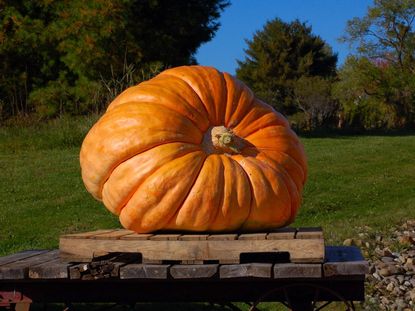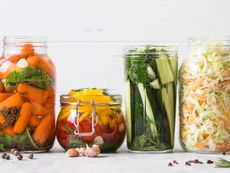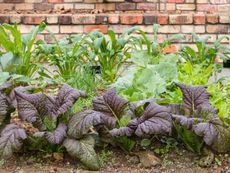Giant Vegetable Plants: How To Grow Giant Vegetables In The Garden


Ever been to the county fair and marveled at the mammoth blue ribbon pumpkins on display or other giant veggie varieties? Perhaps you have wondered how on earth they grow these giant vegetable plants. Despite their massive size, growing huge vegetables requires a lot of TLC, intensive prep work, and patience. Gird yourself with these and the following information about giant vegetable plants, and you too may find yourself with a ribbon or a trophy; at the very least you will have fun!
Types of Giant Garden Vegetables
Do some research and decide what giant veggie varieties you would like to attempt to grow. There is quite a variety beyond the gigantic pumpkin, although those are quite dramatic with the world's record going to a 1,400 pound behemoth. Giant veggie varieties of broccoli (35 lbs., 16 kg.), carrot (19 lbs., 8.5 kg.), beet (43 lbs., 19 kg.), celery (49 lbs, 22 kg.), and red cabbage (45 lbs, 20 kg.) to name a few, are some of the massive produce that can be grown. Seeds, although a bit pricey, can be purchased from seed catalogs for giants such as:
- Big Zac and Old Colossus heirloom tomatoes
- Oxheart carrots
- Giant Cobb Gem or Carolina Cross watermelons
- Atlantic Giant pumpkins
Other giant veggie varieties of seeds specifically chosen for their inordinate sizes are:
- Tropic Giant cabbages
- Giant Silo corn
- German Queen and Beefsteak-type tomatoes
- Big Bertha green peppers
- Kelsea Giant onions
- Gold Pak carrots
Another option for growing huge vegetables is to save seed from particularly large produce which you have grown for sowing the following season; this doesn't work with hybrids though.
How to Grow Giant Vegetables
Enticing isn't it? Now the question is how do we grow giant vegetables? Number one order of business is soil. Growing giant veggie varieties must have nutrient rich, well draining soil. It's a great idea to amend the soil with as much organic matter as possible along with nitrogen prior to winter. Then in the spring, till the soil as deeply as you can, especially if growing giant root crops, like carrots, since they need lots of loose soil for their huge roots. Also, creating raised beds to encourage better drainage of the giant vegetable plants is a plus and be sure to plant the giant in full sun. Fertilization is, of course, key. The large pumpkin, squash, and melon varieties may need liquid fertilizer once a week, while the smaller root crops need a bit less frequent feedings. Leafy veggies, such as cabbage, require high nitrogen fertilizer. The type and frequency of feeding is dependent upon the type of veggie you are growing. A slow release organic fertilizer that continuously feed the giant over the course of the season is ideal. A rule of thumb is to fertilize with high phosphorus food before plants are pollinated and high potassium content once fruit is set. Organic gardeners should water daily with compost tea. Plant your giant veggie varieties as soon as possible in the spring to take advantage of the longest possible growing season and water them well. These giants need water! You may water by hand if you only have a few plants or drip irrigate. Drip irrigation provides the boon of a slow supply of water to the roots and is more effective than large amounts delivered less frequently, which can stress your giant babies out and result in cracking the fruit. Okay people, if you are like me, this is the tough part. Remove all the veggies from the plant except 2-3 of the healthiest with the eventual goal of removing all except the best one to encourage the plant to put all of its energy into growing a giant. Place a porous mat under the growing giant to protect it from rot and pests and keep the giant clean. Inspect daily for pests and take immediate (using non-toxic methods like hand picking) action to exterminate them. Keep the area around your prize weed free.
Final Thoughts on Growing Giant Veggies
Another question you may have upon beholding your giant vegetable is “are giant vegetables edible?” Well, they could be eaten, but often giant veggie varieties are grown for the attribute of their shocking size, not flavor. Chances are you are growing the giant for bragging rights anyway and not to consume, so enjoy the novelty and excitement of growing the “biggun” without thought to actually eating it. Be patient when growing your giant and talk to other folks who have successfully grown giant vegetables. They will often be a font of information as well as proud to share their success stories.
Gardening tips, videos, info and more delivered right to your inbox!
Sign up for the Gardening Know How newsletter today and receive a free download of our most popular eBook "How to Grow Delicious Tomatoes."

Amy Grant has been gardening for 30 years and writing for 15. A professional chef and caterer, Amy's area of expertise is culinary gardening.
-
 10 Best Apartment Plants To Turn Your Small Space Into An Oasis
10 Best Apartment Plants To Turn Your Small Space Into An OasisThe best apartment plants can lend an ambience of the tropics, brighten up a space, or add a touch of drama, and turn an apartment into a relaxing oasis.
By Amy Grant
-
 Grow a Bathroom Oasis: 8 Best Bathroom Plants With No Light or Low Light
Grow a Bathroom Oasis: 8 Best Bathroom Plants With No Light or Low LightSome apartment dwellers grow the best bathroom plants with no light or low light. Read how one of our favorite plant lovers does it in the big city.
By Teo Spengler
-
 How Many Vegetables To Plant Per Person For A Year
How Many Vegetables To Plant Per Person For A YearGauging how much to plant in a vegetable garden can eliminate waste while still producing enough for your family. Click for more.
By Bonnie L. Grant
-
 13 Perennial Fruits And Vegetables You Only Have To Plant Once
13 Perennial Fruits And Vegetables You Only Have To Plant OnceLooking to set it and forget it? Find out which fruits and vegetables can be grown as perennials.
By Laura Miller
-
 11 Edible Plants For A Year-Round Garden In A Bucket
11 Edible Plants For A Year-Round Garden In A BucketWant to know how to grow food inside your house and which foods do best indoors? Click here to learn all about it.
By Bonnie L. Grant
-
 Frost Tolerance Of Vegetables From Least To Most Hardy
Frost Tolerance Of Vegetables From Least To Most HardyHow cold can vegetables tolerate? Knowing which veggies will survive frosts and freezes is essential for the success of your garden. Click here for more.
By Laura Miller
-
 Best Vegetables To Pickle Straight From The Garden
Best Vegetables To Pickle Straight From The GardenPickles aren’t limited to just cucumbers. Read on for tips on pickling your fresh veggies.
By Amy Grant
-
 Benefits Of Planting In Fall Vs. Spring Vegetable Plots
Benefits Of Planting In Fall Vs. Spring Vegetable PlotsLearn why some vegetables do better if you plant them in fall instead of spring.
By Laura Miller
-
 Interplanting Vegetables In The Fall Garden
Interplanting Vegetables In The Fall GardenLearn all about the benefits of interplanting vegetables for your fall garden.
By Laura Miller
-
 Best Vegetables For Growing In Perlite
Best Vegetables For Growing In PerlitePerlite is a natural growing medium that comes from super-heated volcanic glass. In some cases, it works better than soil. Read on for more info.
By Laura Miller